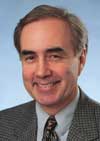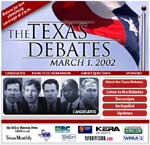Spring 2002
Anchoring the People in TV News Coverage of the Political Campaigns
By Dave Iverson
Executive Director
Best Practices in Journalism
 In Dallas, KERA-TV’s Rick Thompson wants to reach Latino voters who previously felt locked out of the state’s political debate.
In Dallas, KERA-TV’s Rick Thompson wants to reach Latino voters who previously felt locked out of the state’s political debate.
In New York, WNBC-TV’s Jay DeDapper wants to cover politics in a way that focuses on people not polls.
In Seattle, KING-TV’s Robert Mak and Mike Cate want to apply their successful ad-watch approach to other aspects of political coverage.
And in St. Paul, Twin Cities Public Television’s Brendan Henehan and Bill Hanley want to force candidates to be straightforward about their priorities and have fun in the process.
These are a few of the challenges reporters face during what is becoming a very odd campaign year. Never has government been more at the center of people’s lives than in the aftermath of Sept. 11. Yet those post-9/11 issues – terrorism, homeland defense, the role of the military – lend themselves more to national debate than to local. And in a non-national election year, voter interest in local and state races has not always been easy to detect. The just-completed California primary, in fact, had the lowest voter turnout on record. It has sometimes felt like Tip O’Neill’s famous dictum should be revised to say: “All politics is national.”
In such a time, covering local politics takes innovation. It takes the ability to connect the dots between what government does and how people lead their lives. People actually do care about the business of government, they just don’t care much about the process of electing. Consider a recent NewsLab survey of people who were turned off to television news. People were asked what kind of stories might make them more interested in watching. The winners? Stories about education, business, health issues (not just “disease of the week”), and local government all scored well. What didn’t was politics. It was as if people said: Tell me what government does – not how it’s made.
So as campaign 2002 begins in earnest, a good starting point for political coverage may be to not call it political coverage. Focus on what candidates would do once elected, not on what they’re doing to get elected.
With that template in mind, here are some innovative examples.
New Texas Talk
 In Dallas, KERA-TV (PBS) decided to turn coverage on its ear – literally. The public station helped organize the first Spanish-language debate between two candidates for governor. Executive producer Rick Thompson says the goal was to open up the debate to “people who may previously have felt locked out of the process.” Texas is one-third Latino, which means that the business of government affects 6.7 million people who may prefer to conduct business in a language other than English. Over two-dozen commercial and public stations carried either the English or Spanish-language hours or both, reaching an audience of over a half million people.
In Dallas, KERA-TV (PBS) decided to turn coverage on its ear – literally. The public station helped organize the first Spanish-language debate between two candidates for governor. Executive producer Rick Thompson says the goal was to open up the debate to “people who may previously have felt locked out of the process.” Texas is one-third Latino, which means that the business of government affects 6.7 million people who may prefer to conduct business in a language other than English. Over two-dozen commercial and public stations carried either the English or Spanish-language hours or both, reaching an audience of over a half million people.
A Different “P”
In New York City, WNBC is telling stories about the problems New Yorkers care about most – housing, education and jobs. Each story is character driven. In effect, they’ve substituted the “p” of political for the “p” of “personal.” Following each story is a breakdown of what the candidates would do about the problem at hand, and whether their proposed solutions are within the purview of the office they’re seeking.
Shared Stories
In Texas, the four Belo-owned stations in Dallas, Austin, Houston and San Antonio will trade stories to examine how each city is contending with similar issues, from education to the economy. Reporters will produce pieces comparing different local approaches, with reports shared across all four stations.
Play Bills
Most politicians have a tendency to shift their priorities depending on whom they’re talking to. Twin Cities Public Television’s Hanley and Henehan have devised what should be a revealing and entertaining exercise. Candidates for the U.S. Senate and for governor will be given a stack of play $100 bills and asked to put their money where their priorities are. The idea, says Hanley, is to push politicians to make choices about a world where not everything can be of equal importance. Viewers can do the same exercise on line and compare their choices with the people they’ll vote for.
Debate Checks
In Boston, WBZ-TV (CBS) will also utilize a version of truth checks during a live gubernatorial debate. The station plans to partner with The Boston Globe to provide instant feedback on the validity of candidate debate claims.
Road Warriors I
Weary of town-hall programs, Wisconsin Public Television and its partners, Wisconsin Public Radio, WISC-TV (CBS) and the Wisconsin State Journal, have come up with a new wrinkle for putting candidates and citizens together: They’re taking politicians on the road with the destination a surprise. Each week, a gubernatorial candidate will be taken to a new city where reporters will document impromptu citizen interchanges in cafes, bowling alleys and barns.
Road Warriors II
Another road-trip approach by WNIN (PBS) in Evansville will tackle a notoriously difficult story to tell: redistricting. Producer Parri Black plans to take a trip down Highway 41, which traverses the length of Indiana’s 8th Congressional District. The idea is to use the highway as a visual metaphor, introducing the people of this newly redistricted seat to each other.
Reality Checks
During the 2000 campaign, Seattle’s KING (NBC) producer Cate and reporter Mak put together a series of effective ad-watch reports. This year they plan to expand their concept to include “reality checks.” The idea is to apply the same fact-checking concept to other forms of political communication from State of the State speeches, to debates, to follow-ups on past campaign promises.
Power Partners
In Kansas City, public station KCPT is joining with KCTV (CBS), The Kansas City Star, KCUR-FM (NPR, PRI), KPRS (a black-owned radio station) and Back Channel (a student project at the University of Missouri) to examine the meaning of leadership in this year’s campaign. Plans include documentary reports, truth checks, debates and feature reports.
Minute Matters
In New York, public stations WNET and WXXI-TV plan to introduce the people of the state to one another as a way of getting at the fractious upstate/downstate divide. The stations will produce one- to two-minute pieces that will run between programs, allowing people statewide to look at problems that matter most to them.
Route 2 Citizen Views
In Maine, public broadcasting’s Don Carrigan is traversing the state to collect citizen viewpoints for a series called “Route 2.”
“Elections are basically about people,” he says, “And we’re hoping this project will let us learn what issues matter most to Maine citizens.” Carrigan will take to the highway in an old pick-up truck and visit parts of the state that are struggling with different issues. He wants to use this “citizen’s lens” to examine what matters most in Maine’s open gubernatorial race and potentially competitive U.S. Senate race.
In the end, all of these approaches represent variations on two basic themes. Focus on what government can or cannot do, while holding candidates accountable for what they say. And, second, focus on people and their problems, not politicians and theirs.
___________________________
BPJ, a project of Wisconsin Public Television, is funded by The Pew Charitable Trusts to help local television stations develop innovative political coverage. It awards grants for demonstration projects and conducts national workshops.
